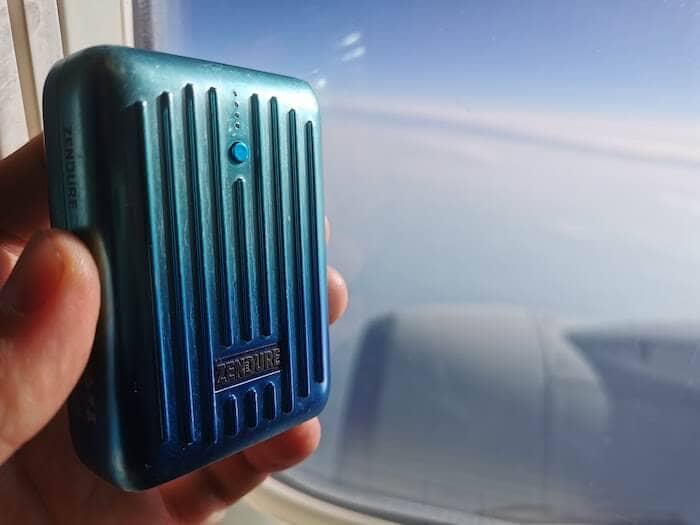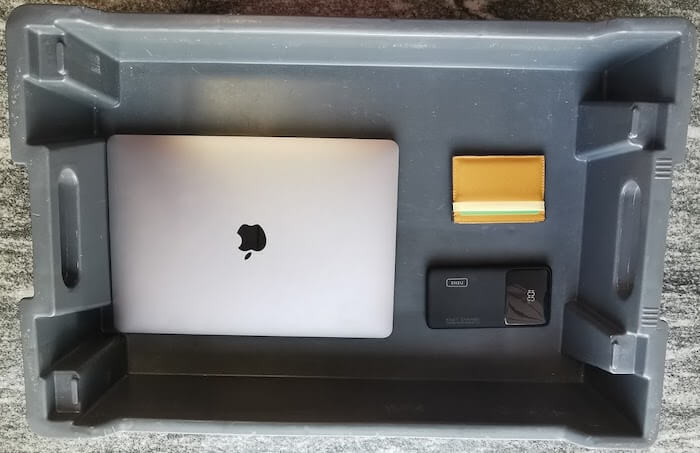Moreover, any Lithium-ion powered Personal Electronic Device (PED) such as a power bank is prohibited in checked baggage. It’s worth noting that you may bring up to 15 electrical gadgets and up to 20 lithium batteries on board.

How to Find Out the Wh Capacity of Your Power Bank
For most power banks, the Wh capacity is printed on them or specified in the user manual. However, certain power banks do not have the Wh label; in this case, you may figure out how much power they have by using simple math.
Wh is calculated using the formula mAh x V / 1000. If you’re pressed for time, you can visit our Wh calculator and enter the mAh and voltage to obtain the Wh.
Ryanair’s Policy on Other Types of Rechargeable Batteries
Personal Electronic Devices
Apart from power banks, other electronic devices such as phones, laptops, gaming consoles, and cameras are also prohibited in checked baggage but accepted in the cabin.

Mobility Equipment
While mobility equipment like segways and hoverboards are forbidden, other mobility types of equipment such as electric wheelchairs and scooters are permitted as long as they meet Ryanair’s regulations.
The battery’s total capacity in the electric wheelchair or scooter should not exceed 300Wh, but if two lithium batteries power it, each lithium battery should not exceed 160Wh. Furthermore, only dry/gel and lithium-ion batteries used in these types of equipment are permitted for Ryanair flights.
Smart Bags
You can take smart bags both as a carry-on and checked-in luggage. However, before you place the smart bag in the overhead compartment or before you check in the bag, you’ll be required to remove the battery. The battery must stay with you at all times during the flight.
Drones/Quadcopters
You can take drones on Ryanair flights as long as their battery capacity is under 160Wh. If they exceed that limit, you’re not allowed to have them with you on the plane, regardless if carry-on or checked-in luggage.
Electronic Cigarettes / Vapes
You can take vapes with you in the carry-on luggage. However, you may not use them during the flight.
How To Store Replacement Batteries During Ryanair Flights
Ryanair recommends that spare batteries must be removed, and the exposed terminals should be protected against short-circuiting. Contact between battery terminals and metal objects, particularly those of other batteries, can cause problems; therefore, battery terminals must be recessed or packed to avoid this.
You should carry the spare batteries in individual bags or their original packaging.
Why Are Airlines So Concerned With Batteries?
There have been multiple incidents of phones and power banks catching fire on airplanes, and Ryanair was no exception.
In August 2018, a power bank caught fire while a passenger was charging his smartphone, luckily before the flight took off. But, imagine if it happened in the checked baggage in the middle of a flight. As a result, the FAA and TSA established rules requiring passengers to carry their battery-powered devices to the cabin and keep an eye on them.
Inside the cabin, be cautious not to lose any battery-powered gadgets, and if you do, alert the crew immediately, as reclining the seat could crush and cause them to catch fire. According to the Federal Aviation Administration’s most recent statistics, “air/airport incidents involving lithium batteries transported as cargo or luggage” occur on average once every 50 days.
Conclusion
Each airline has its regulations regarding the carrying of electronic devices, and you should visit their website to review the whole terms and conditions of carriage prior to booking. In case you do not comply with the regulations, you may be forced to leave your pricey electronics at the airport.
If you’re curious to learn more about flying with power banks, check out this article: What types of power banks are allowed on a plane? 3 TSA rules you need to know.
